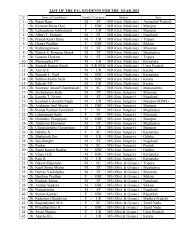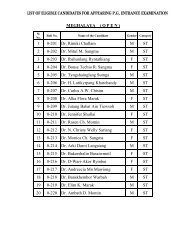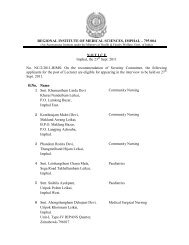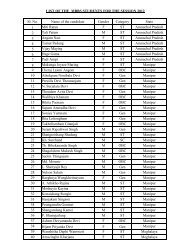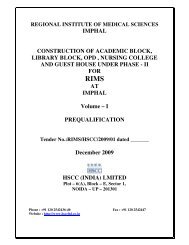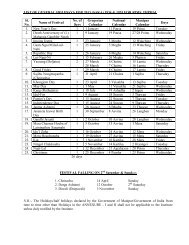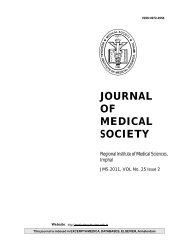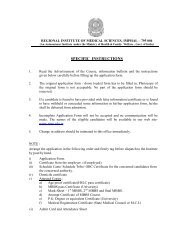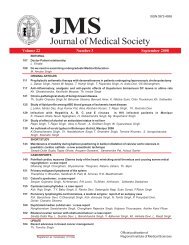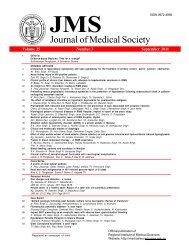Evidence-based Medicine: Time for a change? - Journal of Medical ...
Evidence-based Medicine: Time for a change? - Journal of Medical ...
Evidence-based Medicine: Time for a change? - Journal of Medical ...
You also want an ePaper? Increase the reach of your titles
YUMPU automatically turns print PDFs into web optimized ePapers that Google loves.
ORIGINAL ARTICLE<br />
behavioral characteristics <strong>of</strong> HIV-infected<br />
South Indian patients in concordant and<br />
discordant heterosexual relationships. 839<br />
concordant patients were compared with 996<br />
discordant patients in his study. Concordant<br />
patients had significantly higher CD4 cell<br />
counts than discordant patients at the time <strong>of</strong><br />
enrolling to care. Their study concluded that<br />
couple-<strong>based</strong> interventions in addition to<br />
proper provision <strong>for</strong> HAART will decrease the<br />
HIV transmission among discordant South<br />
Indian married couples. 7<br />
A study from Canada has postulated that a<br />
cumulative effect due to cellular immunity, viral<br />
characteristics, and co receptor integrity could<br />
be the reason behind the seronegativity results<br />
after studying 11 discordant couples. There<br />
is no single reason behind the resistance to<br />
HIV infection 8 . Immunoglobulin A (IgA)<br />
responses found in the cervico-vaginal fluids<br />
<strong>of</strong> sex workers in Thailand as well as in other<br />
discordant groups, suggests that local<br />
mucosal immune responses might be the<br />
reason behind the persistent seronegativity . It<br />
has been studied that purified IgA from HIV<br />
resistant sex workers have a neutralizing effect<br />
towards HIV isolates from different clades and<br />
inhibit HIV infection <strong>of</strong> susceptible cells in vitro.<br />
This provides further evidence that IgA may<br />
be an important part <strong>of</strong> the immune defense<br />
against HIV 9, 10 . In literature there is evidence<br />
<strong>of</strong> elevated levels <strong>of</strong> IgA, IgG and IgM which<br />
are believed to suppress HIV, in the<br />
cervicovaginal secretions <strong>of</strong> a cohort <strong>of</strong> HIVseronegative<br />
African sex workers, suggesting<br />
that the immune response may not be limited<br />
to just IgA (Belec et al.) 11 .<br />
It is postulated that cytotoxic T-lymphocytes<br />
(CTLs) might have a role in resistance to HIV<br />
infection although the resistance is believed<br />
to be dependent on persistent exposure to<br />
HIV. 12 This type <strong>of</strong> responses have been<br />
found in babies born to infected mothers,<br />
regular sexual partners <strong>of</strong> HIV-infected<br />
individuals, and sex workers with high levels<br />
<strong>of</strong> exposure to HIV. 13 Rowland-Jones et al in<br />
their work on sex workers in Nairobi who were<br />
HIV seronegative had discovered CTL<br />
responses targeting epitopes defined by HIV<br />
clade B. 14 A study in HIV seronegative Kenyan<br />
sex workers, found that HIV-specific CD8+ T<br />
cells in the genital mucosa <strong>of</strong> the sex workers,<br />
suggesting that CTL responses were<br />
protective against heterosexual transmission<br />
<strong>of</strong> HIV infection (Kaul et al). 15 Another study<br />
by the same author among a cohort <strong>of</strong><br />
exposed-uninfected Kenyan sex workers, a<br />
subset who seroconvert <strong>for</strong> HIV infection were<br />
found to have had lapses in sex work. This<br />
apparent interruption in HIV exposure might<br />
have lead to loss <strong>of</strong> HIV-specific CD8+<br />
responses, suggesting that constant or<br />
frequent exposure to HIV is needed to<br />
maintain a protective CTL response. 16<br />
A study among the Chinese males had shown<br />
that 30% <strong>of</strong> the persistently negative<br />
individuals have HIV-1 specific T cell immune<br />
responses. 17 Though various studies explains<br />
the evidence <strong>for</strong> CTL involvement in resistance<br />
to HIV infection there is no conclusive<br />
evidence, leaving the possibility that CTLs are<br />
surrogate markers <strong>of</strong> some other<br />
mechanism. Thomas et al in their study have<br />
confirmed the reduced expression <strong>of</strong> CCR5<br />
in HIV-1 resistance. This reduced expression<br />
<strong>of</strong> CCR5 could be the reason <strong>for</strong> the<br />
seronegativity. 18 A study among high risk<br />
individuals <strong>of</strong> Indian origin had concluded that<br />
single nucleotide polymorphism (SNP) in<br />
Stromal Derived factor (SDF-1); a ligand <strong>for</strong><br />
CXCR4 could be a protective factor towards<br />
HIV infection. 19, 20 Another study by Sangok et<br />
al showed a high expression <strong>of</strong> CD26/DPPIV<br />
enzymes in exposed seronegative individuals.<br />
This opens a new dimension <strong>of</strong> CD26/DPPIV<br />
in protection against HIV infection in vivo. 21<br />
DPPIV enzymes are the enzymes which are<br />
implicated in the carbohydrate metabolism.<br />
Stan<strong>for</strong>d et al in their study had observed a<br />
strong non-cytotoxic CD81-cell anti-HIV<br />
response in discordant persons suggesting<br />
that this might be a contributing factor <strong>for</strong> the<br />
reason towards the persistent negativity<br />
Though various postulates have been given<br />
<strong>for</strong> the persistent seronegativity or HIV<br />
resistance /susceptibility, we could not<br />
evaluate the reason <strong>for</strong> the discordance in our<br />
patients due to lack <strong>of</strong> resources. An insight<br />
towards the resistance or susceptibility to HIV-<br />
1 infection is important in the context <strong>of</strong> future<br />
treatment modalities and research towards<br />
22 JMS * JMS Vol 25 * Vol * No. 25 3 * No. * September, 1 * June, 2010 2011




